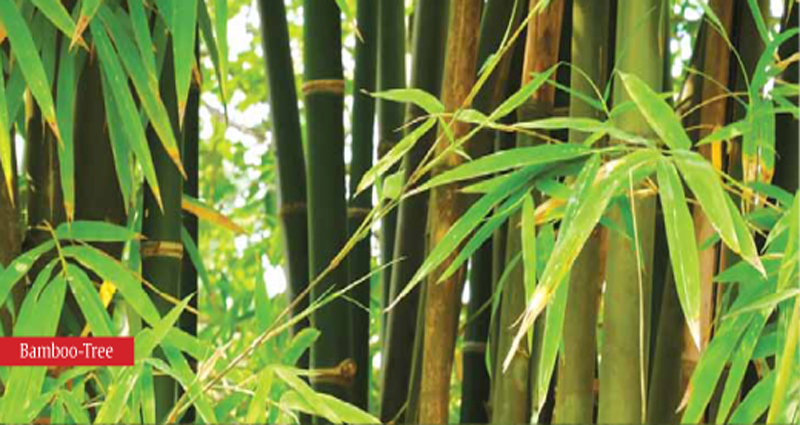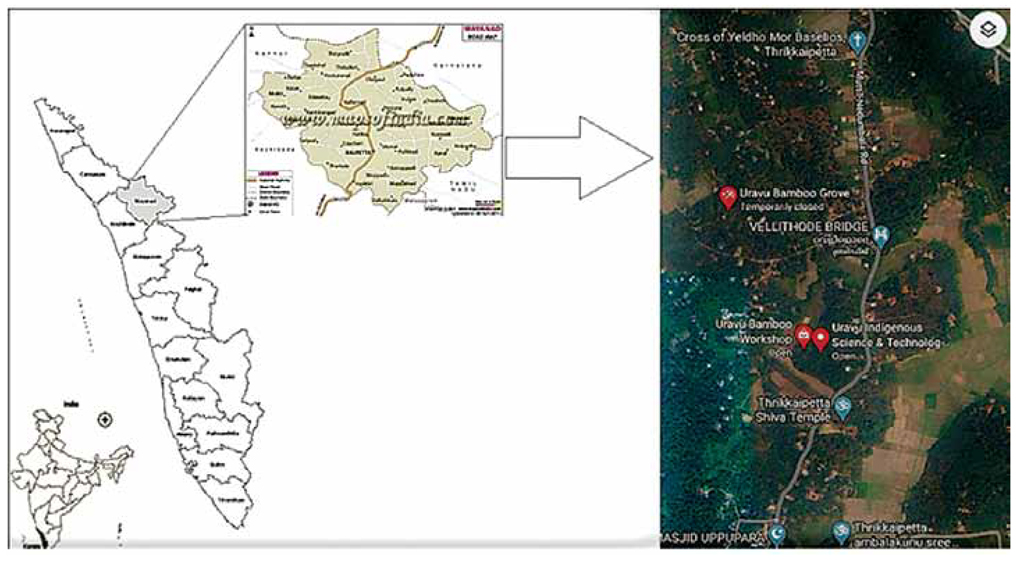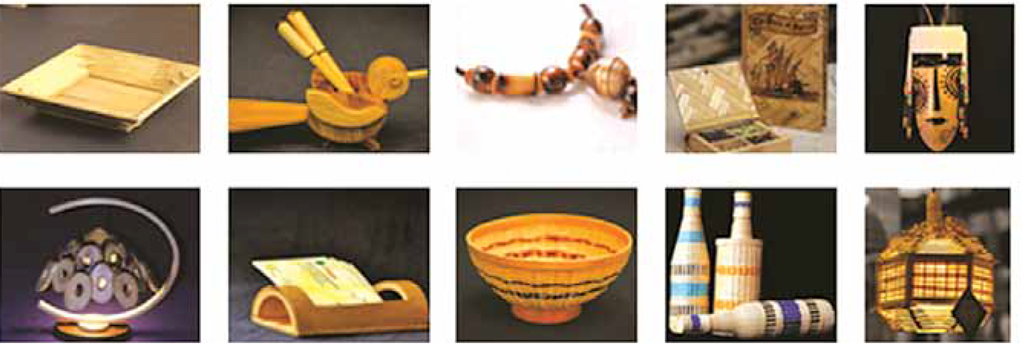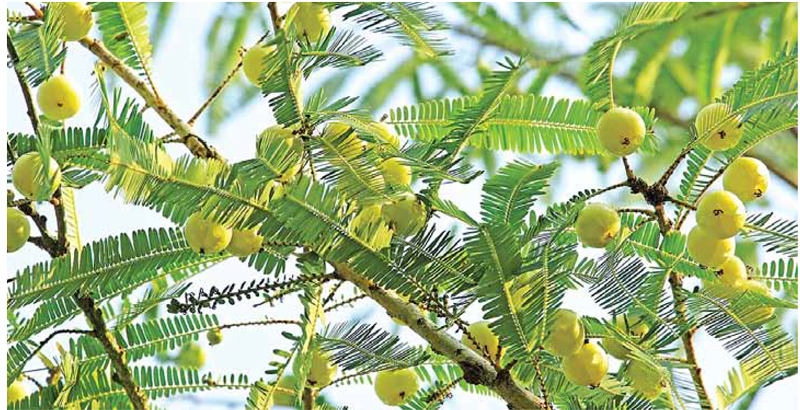
Bamboo and Beyond: A case study of Uravu an NGO from Wayanad, Kerala
By Pavithra G.M., Prabhakaran N., Shyni, Venkataramana G.V, Department of Environmental Science, Manasagangotri, University of Mysore, Mysore
Abstract- Bamboo Mission’s main goal is to inspire, start, create, and implement sustainable development processes from the foundations of eco-fraternity. Uravu is a non-profit bamboo-based organization that aims to empower rural communities by providing long-term solutions to promote rural and tribal livelihoods. Uravu is a bamboo community indigenous science and technology to promote socio-economic and sustainable development projects in the bamboo sector while also supporting environmental initiatives. Bamboo is one of the most important natural substitutes for plastic, iron, and wood. Uravu has been developing products and projects that take advantage of bamboo’s potential to promote a more sustainable lifestyle. One-stop-shop for a gallery of Lifestyle Products SHGs, Blinds SHGs, Organizational Structure, and Sustainability.
Keywords: Uravu Indigenous Science and Technology Study Centre, Self Help Groups (SHGs), Rural and tribal livelihood
I. Introduction
The major purpose of Bamboo Mission is to inspire, initiate, design, and implement sustainable development processes based on eco-fraternity. Uravu is a bamboo-based non-profit organisation whose mission is to empower rural people by delivering long-term solutions to improve rural and tribal livelihoods. Uravu It’s a bamboo community that uses indigenous science and technology to promote socioeconomic and sustainable development projects in the bamboo industry, as well as environmental activities (Thadathil, 2015). Uravu has been producing goods and projects that take advantage of bamboo’s potential to create a more sustainable lifestyle because it is one of the most important natural substitutes for plastic, iron, and wood. Self- Help Groups (SHGs) for lifestyle products, bamboo blinds, organizational structure, and sustainability in one place. Follow Uravu’s path from 1996 to 2020 in the context of Bamboo natural resource development, sectorial interventions, skill development, value addition, and training programmes. Also develops ways for Indigenous village knowledge systems to solve resource constraints and commercialization issues. To realise Bamboo’s full potential and establish it as the best wood, plastic, and iron substitute.To meet the need for raw materials, the cultivation of appropriate multipurpose bamboo species such as D.stoksii (Munro.) on a plantation scale is encouraged (Rane et al., 2016).
Bamboo for Climate Change and Carbon Market Opportunities:
Bamboo acts as a potential carbon sink for carbon storage (Seetalakshmi et al., 2009; Song et al., 2011). Uravu also makes bamboo pickles and other delectable bamboo edibles from young bamboo shoots, which is a typical South Indian dish (Viswanath, et al., 2015; Satya et al., 2010). Bamboo kheer, also known as bamboo payasam, is a popular treat produced from bamboo rice that is also high in nutritional value for a healthy lifestyle (Chadramouli, et al., 2015). Uravu Organisational Structure is comprised of Board of Trustees to discuss the objectives and formulate the ideas, the link is further followed Managing Trustees board to channelize the discussions to the decision and followed by the Advisory Group and Chief Executive Officer (CEO) who handles the execution of projects and financial responsibilities.
| 1996 | Uravu was established on 7th July to preserve and promote indigenous knowledge streams. |
| 1997 | With the help of legendary bamboo lover Vinu Kale, brought in Maharashtra master craftsman Bhimrao Chaple. Central government’s first training program STED (Science and Technology Entrepreneurship Development) project. Organized for 20 young people in the SC community. |
| 2000 | Office building and 250 sq. Ft. machine room was established with the support of NABARD. Involvement in Peoples Plan Program and reorientation of the activities to provide emphasis on women’s economic empowerment. A Bamboo Treatment plant was established with the support of the National Mission for bamboo applications. A bamboo nursery was set up with the help of district panchayat. |
| 2001 | Uravu started providing training and conducting exhibitions all across the state. Ambedkar Hast ShilpVikas Yojna approved by Development Commissioner Handicrafts) facilitated training tribal families and artisans trained under this project were grouped into 6 SHGs. |
| 2002 | Uravu organized a Design Workshop in collaboration with IDC, IIT (MUMBAI), and KVIC (Khadi and Village Industries Commission). Constructed a smokehouse with the support of IDC. |
| 2003 | CAPART (New Delhi) sanctioned a project to Uravu for imparting advanced production training to 60 persons and enhancing the capacity of the training centre. |
| 2004 | Under the RSVY (Rashtriya Sam Vikas Yojana), more than 500 people from Wayanad were trained with bamboo handicraft techniques and support was given to them to setup handicraft units. Buildings were revamped and new block was built in the RSVY project. |
| 2005 | Uravu Ecolinks, a private limited company was established to facilitate marketing and sales of bamboo handicraft products. |
| 2006 | Partnered with UNDP (United Nations Development Project) for Conservation and Sustainable Management of Non-timber Forest Products through a Participatory Approach in the Western Ghats, Kerala. |
| 2008 | SFURTI (Scheme of Fund for Revitalizing Traditional Industries)- Cluster Development Programme was initiated which paved the way to establishing Kalpetta. Bamboo Cluster and organizing Self-Help Groups working on Bamboo crafts under this. |
| 2010 | Uravu organized an International Workshop for Design Exchange and Skill Development in Thrikkaipetta along with Ori Ben-Zvi, designer and traveller, and his team of design students from the HIT (Holon Institute of Technology) in Israel. |
| 2013 | Capacity Building Programmes at Uravu initiated by SFURTI was successfully concluded. |
| 2017 | Partnered with Maharashtra Small Scale Industries Development Corporation Limited for a training program for developing Master Craftsmen for Sindhudurg Bamboo Project. |
| 2018 | Bamboo Art Gallery was established. Nursery shifted to a new lease land with modern facilities. Introduction of Bamboo Art and Interior sector. Partnered with Maharashtra Small Scale Industries Development Corporation Limited for a training program for developing Master Craftsmen for Sindhudurgh Bamboo Project. Partnered with IISC (Indian Institute of Science) for a project of developing mathematical toys in bamboo. |
| 2019 | First Art Exhibition of Art wing- Hiraeth was organised in Bengaluru. Partnered with UNIDO (United Nations Industrial Development Organization) for providing training on basic bamboo craft techniques for developing a bamboo supply chain and product industry in Sri Lanka. |
II Material and Methods
It’s a simple random survey conducted to understand the working mechanism of bamboo-based (non-profit) Non governmental organisation (NGO).
Uravu Organisational Structure, Bamboo Nursery, Livelihood Support Programme, Common Facilities Centre (CFC), Bamboo Interior, Uravu Stores, Advocacy and Consultancy, Bamboo Art and Installations.
Art Gallery at Uravu exhibiting Bamboo Blinds and Lifestyle Products
linds and Lifestyle Products. Trainings and Workshops and Tales of Empowerment of Uravu.
1. Uravu Organisational Structure:
List of Board of Trustees, Managing Trustees, Advisory Group and Chief Executive Officer (CEO)
| Dr. Abdullakutty A K President | T Sivaraj Secretary |
| Antony C P Treasurer | Tony Paul CEO, Uravu |
| Surendranath C, Ex- journalist, The Hindu | Lenin C P Chief Designer, Uravu |
| C.D. Suneesh, Advisor, Ministry of Agriculture, Kerala | Prof. A G Rao, Professor, IDC, IIT Bombay |
| Baburaj M, Farmer, Social Activist | Dr. Syam Viswanath Director, KFRI |
| Dr. K. K. Seethalakshmi Chief Scientist (Retd), KFRI | V M Jayadeven, IRS, Assistant Commissioner, Income Tax |
| K. K. Salim Artisan |
The SHGs or the producer groups are divided into two categories based on their ability and capacity and the level of support they choose.
(a) Dependent Units: A unit/ producer group/ artisan with a separate and independent existence who choose the five major layers of support i.e., Raw material, Training, Technical, Design and Marketing Support. Usually they are layman artisans mostly women who require designs and technical knowhow to sustain. Our Research and Development wing feeds them with the expertise to prosper and they are completely dependent upon Uravu to sustain.
(b) Independent Units: A unit/ producer group/ artisan with a separate and independent existence who is capable enough to sustain themselves. They might choose any of the five major layers of support i.e., Raw material, Training, Technical, Design and Marketing Support, but not all.
| Sl. No | Dependent Units | Independent Units |
|---|---|---|
| 1 | Dreams | Bhavam |
| 2 | Shilpi | Unarvu |
| 3 | Niravu | Urvara |
| 4 | Pulari | Travancore Art and Craf |
| 5 | Varnam | Thrikkaipetta Pickles |
| 6 | Soubhagya | Shrooms |
| 7 | Swaraj | Uravu Bags |
| 8 | Sneha | Fatima Dry flower |
| 9 | Peeli |
Rural artisans, majorly women from these SHGs produce Bamboo Lifestyle Products and Bamboo Blinds.
III RESULTS AND DISCUSSION
Uravu set-up some of the major Sustainable Development Goals (SDG’s) to accomplish its vision and mission for sustainable livelihood. They are as follows.
SDG 1: No Poverty
Uravu’s livelihood support program primarily focuses to address the issue of rural poverty in Wayanad- the Vidarbha of Kerala- a district famous for its pristine natural beauty but also unfortunately for farmer’s suicide. Through our focused intervention we aim to help the rural population to find and establish alternate and sustainable sources of income./p>
SDG 5: Gender Equality
UThe beneficiary of our livelihood support program is rural women from impoverished backgrounds. Uravu believes that women’s economic empowerment would essentially strengthen their voices, which in turn would contribute to the root cause of gender equality and also overall growth and development by providing them with exposure and self-belief to change and challenge their lives.
SDG 8: Decent Work and Economic Growth
Uravu’s interventions in modernizing, upgrading, and streamlining bamboobased economic activities have tremendously helped to improve the social status of bamboo artisans in Kerala. Uravu helped in mainstreaming bamboo crafts and other bamboo-based occupations by removing the caste perceptions associated with it. Our activities have directly contributed to transforming the village economy as well. Thrikaipetta, which had just eight families working in bamboo in 1996, is known today for its expertise in bamboo and is identified and acclaimed across the globe as a bamboo village and the bamboo headquarters of Kerala
SDG 12: Responsible Consumption and Production
Uravu’s bamboo nursery is the largest in South India in terms of species diversity and hosts more than 50 different species. The sustainable model of Uravu ensures efficient management and consumption of this renewable resource by promoting bamboo plantation and advocating it as an ultimate substitute for wood, plastic, and iron.
SDG 13: Climate Action
Uravu’s experiments and explorations in the Bamboo industry are equally fuelled by the environmental benefits of the Green Gold. Bamboo is one of the most important nature’s substitutes for the endangered rainforest hardwoods. It is a quick-growing, versatile, non-timber forest product whose rate of biomass generation is unsurpassed by any other plants. It spreads to other locations by virtue of multifarious uses (Rao et al., 1998 and Banik, 2000).
It absorbs more carbon dioxide and releases more oxygen than any other plant species and is an effective erosion control plant. Serious attempts are made through our nursery to increase bamboo cover and promote it as an agricultural crop. Bamboo wastes generated by making bamboo products can be used in electricity generation through gasification process (Kumar and Chandrasekher, 2014). Bamboo charcoal is also a versatile use of bamboo waste like twigs, shavings etc., (Dwivedi et al.,2019)
The primary objectives of the Livelihood Support Program are to ensure that
- The SHGs/producer groups particularly the most vulnerable ones have regular employment and source of income.
- The SHGs/producer groups receive pre and post production facilities with optimum quality.
1. Creation and distribution of quality planting material
In this section how many species are currently available in a bar diagram the quantity of material sold over the past decade may be indicate.
The involvement of Uravu in taking up plantation program, area covered under bamboo due to interventions of Uravu in Wayanad, in other districts of Kerala. Uravu practises the traditional method of bamboo treatment and preservation for longitivity and also for the improvement of mechanical properties by vacuum pressure process for quality bamboo products (Rabbiet al., 2015; Cheng et al., 2006). In this subsection the focus can be on dependent and independent units created. The raw materials used in each unit and the end product. A discussion on problems and prospects of each of the units can be included.
3. Bamboo life style products by Uravu
Bamboo is one of the vital nature’s substitutes for the endangered rainforest hardwoods. It is a quick-growing, versatile, non-timber forest product whose rate of biomass generation is unsurpassed by any other plants (Zhou et al., 2005)(Fig.6)
Socio-economic sustainability programs by Uravu Training Programs for disseminating knowledge. Program on awareness workshops through:
- URAVU TRUST and
- URAVU ECOLINKS
Livelihood support program striving to ensure regular work days and income for members of affiliated SHGs/ producer groups. Identification and promotion of diverse income-generating opportunities. Integrated collaborative working model to balance the infant nature of the industry and to ensure regular revenue generation. Forward and backward linkages for SHGs/producer groups to ensure regular employment and income generation.
1. Uravu Bamboo Nursery:
Bamboo Nursey is one of the defining features of Uravu’s model. The nursery primarily strives to provide assistance for eco-restoration programmes and to ensure the availability of raw materials for Bamboo based production units. With more than 50 species commercially available, our nursery is the largest in South India in terms of species variety. We have a wide range of both garden and agricultural verities of bamboo. Bamboo is the most prominent component in central governments ambitious project to double the farmer’s income by 2022. Apart from supplying saplings, Uravu also take up plantation and plantation management programs on a contract basis
2. Bamboo blinds and lifestyle products
Uravu set-up some of the major Sustainable Development Goals (SDG’s) to accomplish its vision and mission for sustainable livelihood. They are as follows.
- Blinds: Handcrafted and elegant, Uravu’s roll-up bamboo blinds are made by the in house SHGs of the common facilities center. It comes in over 20 patterns and shades, allowing different degrees of sunlight filtering and privacy. Handmade slivers provide greater durability and treated bamboo wards of borers
- Bamboo Lifestyle Products: With an exclusive collection of more than 500 products, Uravu has a pioneering role in setting benchmarks in the bamboo industry. Though little known to the outside world, Uravu’s women folk are trained and equipped to create wonders in bamboo – from Masks and Lampshades to Bamboo pens and Baskets, creativity of our artisans knows no limits!
Uravu store is a paragon of creativity and craft making. Uravu have an exquisite range of handcrafted products across eight different categories. Uravu make sure that the best of the bamboo products can be bought from anywhere in India. Our fully functional E-commerce website facilitates quick and hassle-free online purchase. www.uravustore.com
4. Training Workshops and other interactive programs
The knowledge Uravu possess in bamboo as a material is our biggest asset and Uravu have been organising different programs to disseminate this. Uravu organize custom trainings and workshops across different domains of bamboo attracting interest from bamboo lovers, government agencies, livelihood organisations, entrepreneurs, artisans, designers, school and college students, tourists etc., the programs include:
- Introduction to bamboo processing and treatment.
- Introduction to Bamboo propagation and Nursery management.
- Introduction to entrepreneurship in Bamboo.
- Basic Hands on experience in Bamboo for tourists, students and nature lovers.
- Custom workshops for college and student groups.
- Basic skill development programs in bamboo products making (10-30 days)
- Skill upgradation workshops
- Product development workshops
- Design transfer workshops
- Comprehensive program to develop master craftsperson’s (2-6 months) other tailor-made programs according to the requirement.
5. Bamboo Common Facilities Centre (CFC)
CFC is the nerve centre of all the activities. It hosts a machine room and has facilities for storing raw materials and bamboo treatment. Bamboo treatment and processing are the primary functions of CFC. The processed raw material is then made available to production units and also supplied outside.
In this section the list of infrastructures available its usage resource sharing pattern and how stake holders are benefitted
6. Bamboo Art and Interior Designing
Uravu stepped into the bamboo interiors sector a couple of years back with the immense experience and expertise it has gained over years with respect to properties and characteristics of bamboo as a building material. Uravu`s touch of bamboo adds grace and a character to any interior space.
7. Art and Installations
With the immense versatility in its species diversity, its strength and flexibility, slenderness and girth, hollowness and wall thickness, local adaptability and universality, bamboo remains a material being explored forever.
8. Advocacy and Consultancy Programs on Bamboo
Uravu advocate for responsible policies that will explore the unseen potential of bamboo to change the societies and economy. Sharing in this search with their innate and acquired talents, Uravu`s master craftsmen make exquisite one-ofits-kind products-masks, lights, woven artifacts, furniture, thematic installations. As a result of the whole efforts Uravu’s illustrated many successful stories of rural empowerment and sustainable livelihood.
9. Challenges faced by Uravu
- Problems in marketing and liquidation.
- Self-employment- waged people addressed largely by NGO Not by any supporting main stream.
- Thriving community- the use of technology between connecting crafts and technology.
- We are facing the other way need to be bridged by educated ones in the society.
- Integration to raise the voice of all artisans and craftsmen
- Craft education should be integrated-based on study contemporary needsintangible aspects, way of life with the other communities to be self-reliant,working together with or without pay, members of that community involved in connective effort, to get the ownership collaborative project this is not the space for outsiders among socio-economic units.
10. The way forward for Uravu: futuristic goals of Uravu
Thrikaipetta village alone today, is transforming the whole village economy. This small rural remote village is known today for its expertise in bamboo and is identified and acclaimed across the globe as a “Bamboo Village”. The State Government has also acknowledged this growth and has declared Thrikaipetta as the first and the only heritage village of Bamboo in Kerala.
IV CONCLUSION
Skill development program to integrate the working class cataloguing based on wages and salaries. “Learn from the past”, the concept of Swadesi Swawarambang has been revised, and the implementation of a centralized system, helps to create a stable flow of funds. Promoting bamboo marketing ideas to improve the self-efficacy and outcome expectations of artisans who practice science through exploration: the meaning of a professional development program. In research and development sector, for sustainability assessment of bamboo plantation there is a great demand in preparation of Environmental Niche Models (ENM). By using advanced software with proper authentication and validation which provides a proper output map of prospective favourable locations to grow suitable species would be very helpful to setup long time observation plots (Bonilla et al., 2010). A research made on B. balcooaspecies studied for identification of potential areas using Ecological Niche Modelling (ENM) tools (Subbanna and Viswanath). Established a tribal museum to preserve the collected treasures and allow interested students to study in more detail. This helps society maintain its resilient traits for indigenous arts skill development in relation to trends. Through this bamboo handicraft and bamboo tourism, useful products should be enhanced.
Documentation of creative work, and supportreward the craftsmen involved in creating assets, raising awareness, raising skills, generating income, activities and achieving the goals of the SDGs in civil society.
ACKNOWLEDGMENTS
The authors are thankful Uravu family, Members of Board of trustees, Major Organizational partners and associates, public help in providing information for the manuscript and their critical suggestions for the paper
The authors are also thankful to Dr. Abdulla Kutty, President of Uravu for all his effort and dedication in framing and maintaining throughout the journey over years with the futuristic goals.
REFERANCES
Banik, R.L. 2000. Silviculture and field-guide to priority bamboos of Bangladesh and South Asia. Chittagong, Government of the People’s Republic ofBangladesh, Bangladesh Forest Research Institute (BFRI). 168-180
Bonilla, S.H., Guarnetti, R.L., Almeida, C.M.V.B., Giannetti, B.F., 2010. Sustainabilityassessment of a giant bamboo plantation in Brazil: exploring the influence of labour, time and space. Journal of Cleaner Production. 18, 83–91.
Castro, C.J., 2004. Sustainable development: mainstream and critical perspectives.Organization & Environment. 17, 195–225. https://doi.org/10.1177/1086026604264910
Chandramouli, S. and Viswanath, S. 2015. Nutritional composition of edible bamboo shoots of some commercially important bamboo species in Peninsular India. Intl. Journal of Basic and Life Sciences. 3(6): 275 – 287.
ciences. 3(6): 275 – 287. Cheng, R.X., Zhang, Q.S., Sui, S.J., 2006. Improvement of softening treatment technologyof bamboo. Wood Science and Technology. 40, 327–335. DOI: 10.1007/s00226-005-0034-9.
Dwivedi, A., Jain, N., Patel, P., Sharma, P., 2014. The versatile bamboo Charcoal. International Journal of Research Science and Innovation. I, 129–131.
Jagadish, M. R; Viswanath, S; Shiva Prakash K. N; Ravikanth, G and T.S. Rathore. 2015. Ecological niche modeling for prioritizing areas for domestication of introduced bamboo species in India. Proceedings of the 10th World Bamboo Congress, Damyang Korea. 1098-1114.
Kumar, Ritesh. And Chandrashekar, N. 2014. Fuel properties and combustion characteristics of some promising bamboo species in India. Journal of Forestry Research. 25(2): 471-476.
Pianka, E. R. and Vitt, L. J. 2019. A Review: Population, population, and populationCohenJ. E. Laboratory of Populations, Rockefeller University & Columbia University, New York, USA. Our One and Only Spaceship: Denial, Delusion, and thePopulation Crisis. Self-published, no place given. 237 pages. ISBN 978-1- 7330305-0-2. https://doi.org/10.1002/ bes2.1694/
Rabbi, Md. F., Islam,Md. M.and Rahman, A.N.M.M 2015. Wood Preservation: Improvement of Mechanical Properties by Vacuum Pressure Process Internation al Journal of Engineering and Applied Sciences (IJEAS) ISSN: 2394-3661, 2(4)
Rane, A. D., Chandramouli, S., and Viswanath, S. (2016). Can Dendrocalamus stocksii (Munro.) be the ideal multipurpose bamboo species for domestication in Peninsular India? Journal of Bamboo and Rattan, 15(1–4), 23– 32
Rao, A. N; Rao, V.R. and Williams, J.T. 1998.Priorityspecies of bamboo and rattan. IPGRI-APO Serdang, Malaysia.
Satya, S., Bal, L.M., Singhal, P., Naik, food qualityand safety aspect (a review). Trends Food Science and Technology. 21, 181-189.
Sawarkar, A. D., Shrimankar, D. D., Kumar, A., Kumar, A., Singh, E., Singh, L., Kumar, S., , Kumar, R. 2020. Commercial clustering of sustainable bamboo species in India. Industrial Crops & Products. 1-12. https://doi.org/10.1016/j.indcrop.2020.112693
Seethalakshmi, K. K., Jijeesh, C. M. and Balagopalan, M. (n.d.). Proceedings of National Workshop on Global Warming and its Implications for Kerala Bamboo plantations:An approach to Carbon sequestration Proceedings of National Workshop on Global Warming and its Implications for Kerala
Subbanna. S and Viswanath, S. 2020 Identifying potential areas for Bambusa balcooa Roxb. using Ecological Niche Modelling tools.Journal of Bamboo and Rattan, ISSN 1569 1594. 18, (1) 01 – 09
Thadathil, E. S. 2015. Assessment of Domain wise Quality of Life among Elderly Population Using WHO-BREF Scale and its Determinants in a Rural Setting of Kerala. International Journal of Current Medical and Applied Sciences, 7(1), 43-46.
Viswanath, S. and Chandramouli Sowmya. 2015. Cultivation prospects of edible bamboo shoots in South India. IWST Technical Bulletin No. 11.
Zhou, B. Z., Fu, M. Y., Xie, J. Z.., Yang, X. and Zheng, C. L. 2005. Ecological functions of bamboo forest: Research and Application. Journal of Forestry Research 16 (2): 143-147.
Links
www.uravu.in.
https://www.keralatourism.org/wayanad/tribal-population.php
https://shodhganga.inflibnet.ac.in/bitstream/10603/46446/12/12_chapter4.pdf
https://in.search.yahoo.com/search?fr=mcafee&type=E210IN885G0&p=present+Population+of+waynad+district

Location map of Uravu, Wayanad with the google image of scale 1: 250000 (Latitude 11º 37’ 30” Longitude 76º 05’ 15” Geographical Area2,12,966 ha)

URAVU Bamboo Nursery

Livelihood Support Programme

Common Facilities Centre (CFC), Bamboo Interior

Uravu Stores

Advocacy and Consultancy

Bamboo Art and Installations


Art Gallery at Uravu exhibiting Bamboo Blinds and Lifestyle Products

Trainings and Workshops at Uravu




